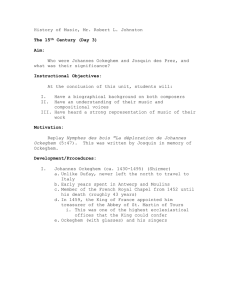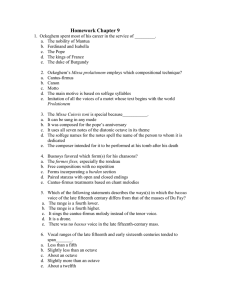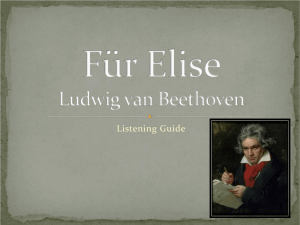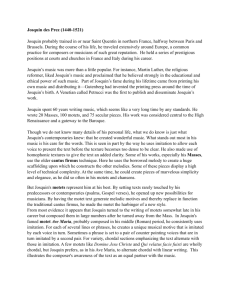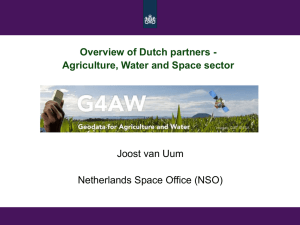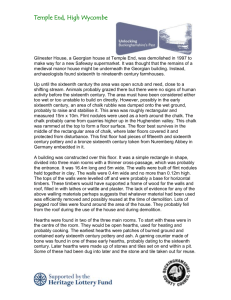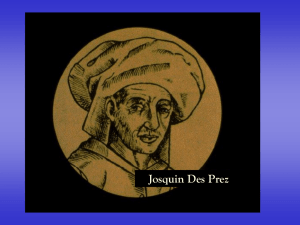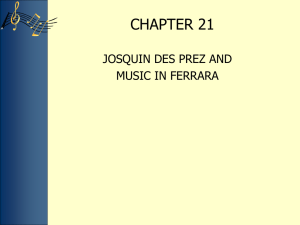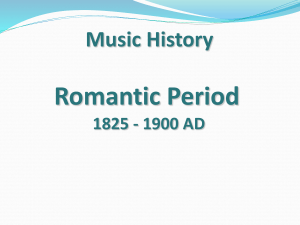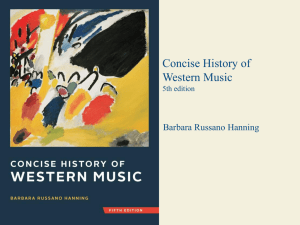The northern composers of the later fifteenth century
advertisement
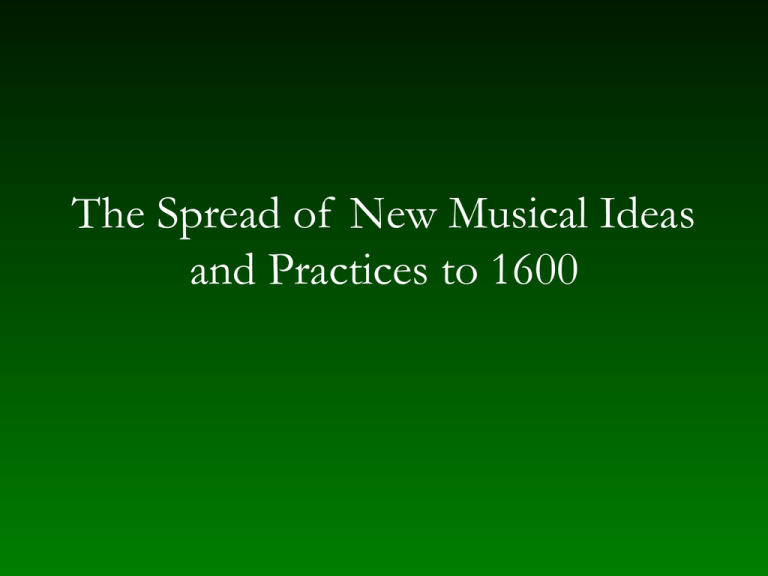
The Spread of New Musical Ideas and Practices to 1600 The Franco-Netherlands group (or just Netherlands or Franco-Flemish) • After the Burgundians, many prominent musicians grew up and trained in present-day northern France, Belgium, and the Netherlands • Traveled widely — especially to Italy Johannes Ockeghem (ca. 1410–1497) • • • • • Singer, composer, director Student of Du Fay, possibly also of Binchois 1443 — choir of Notre Dame 1445 — Burgundian chapel Paris — court of the kings of France – Charles VII through Louis XI Ockeghem’s works • Twelve Masses — expanded on Du Fay’s style – cantus firmus type – complex styles — intricacies reflect lingering medievalism • Ten motets in new style – – – – monotextual equality of parts, no c.f. panconsonance with imperfect consonances through-composed • Twenty chansons — older cantilena type and newer style like motet Ockeghem’s style • Scoring • • • • – more homogeneous than preceding style – dark sound — dense – low pitch (composer sang bass), added bass part in clearly lower range than tenor Rhythm — fluid Melody — long phrases, little direction Modal — mystical effect Canon — “rule” for realizing several parts out of one — takes place of isorhythm for showing composer’s skill Josquin des Prez (ca. 1450–1521) • Regarded in the sixteenth century as culminator of period style, most skillful • "Josquin is master of the notes, which must express what he desires; other choral composers must do what the notes dictate." Martin Luther Josquin’s career • Netherlands native and died there, wide-ranging career – born in northern France – studied with Ockeghem • Travel to Italy — characteristic for Netherlands composers – Milan • cathedral 1459 • patronage of Sforza dukes 1474–1484 – Rome — Papal chapel 1486–1494 • Return to France — royal court 1501–1503 • Return to Italy — Ferrara, court of Duke Ercole 1503 • Netherlands — collegiate church of Condé Josquin’s works • Twenty Masses — conservative — often derivative material – cantus firmus – fuga based on paraphrase of preexisting melody – parody – soggetto cavato • Ninety-five motets — offered more freedom, textual inspiration than Mass Ordinary – more progressive than Masses – texts from liturgy, Bible, prayer – techniques — c.f., paraphrase, free • Ca. seventy secular pieces — most progressive – Netherlands style of chanson — like motet • generally more familiar style, rhythmic, syllabic • some in fixed forms, others free • four parts in fuga or familiar style, rather than older three-part texture – Italian — frottola — lighter • Some instrumental (untexted) pieces Secular music in the fifteenth and sixteenth centuries Amateur music-making Regional traditions Printing and the spread of literacy • Johannes Gutenberg (late fourteenth century to 1468) – invention of printing from movable type – Bible completed by 1455 Music printing • Ottaviano Petrucci (1466–1539) – music printing from movable type – Harmonice musices odhecaton A (Venice, 1501) Music for social use • Rise of educated, literate class • Musical self-entertainment in the home • Musical participation as mark of social status and culture Netherlands chanson • Conservative — motet style – polyphonic — fuga – rhythmically fluid • Important publisher — Tilman Susato (ca. 1500–1560), Antwerp French chanson • Familiar style, rhythmic • Composers – Claudin de Sermisy (ca. 1490–1562) — court of Francis I, traveled to Italy with court – Clément Janequin (ca. 1485 to ca. 1560) — church musician, but known mostly for secular pieces • onomatopoeic pictorialisms — La Guerre, Le Chant des oiseaux • Publisher — Pierre Attaingnant (1494–1552), Paris — from 1528 German Lied • Monophonic tradition of noble Minnesinger continued by trade-guild Meistersinger • Polyphonic pieces tend to older style – often canonic imitation – tenor-oriented – frequently incorporated existing monophonic song tunes • Composers – Heinrich Isaac (ca. 1450–1517) – Ludwig Senfl (ca. 1490–1543) Spanish villancico • Popular song or modeled on style of popular music • Rhythm — strongly marked, generally duple, but rather irregular • Texture — homorhythmic; three to four voices, early with text in highest part only, later more parts sung • Form — similar to earlier fixed forms – estribillo (refrain) — text abba or abab, music A = abcd – coplas (stanzas), separated by return of estribillo • mudanza — text cddc or cdcd, music BB = efef • vuelta — text abba or dbab, music A = abcd • Composer Juan del Encina (1468 to ca. 1530) Italy — the frottola • • • • • • • Vernacular poetry on amorous or satirical topics Syllabic Familiar style (top-voice orientation) Strong, patterned rhythms Simple, diatonic harmony Strophic form Representative composer, Marco (Marchetto) Cara (ca. 1465–1525) Italy — the madrigal • Sources – Netherlands-style polyphonic chanson – frottola – excellent poetry • Petrarch sonnets — from fourteenth century • Italian humanist poets of sixteenth century • Stages of development – Netherlands composers — simple, restrained style • ex., Jacques Arcadelt (1504–1567) – growing expressive devices, complexity • ex., Cipriano de Rore (1516–1565) Questions for discussion • Did national taste, the predilections of particular patrons, and the personalities of composers affect music more in the late fifteenth and sixteenth centuries than in earlier periods? • How did the printing of music affect musical style starting in the sixteenth century? Might it have had any negative effects on music? • In what ways did the relationship of music to words increase the vitality of music in the sixteenth century? What might music have lost in exchange?

